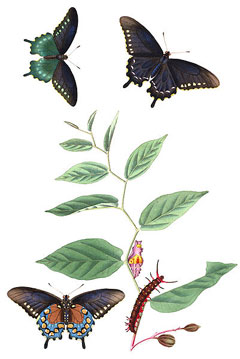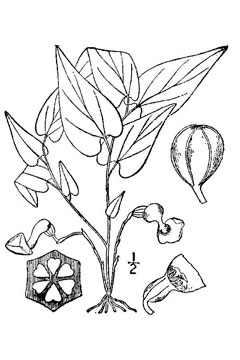 |
|
http://commons.wikimedia.org/wiki/File:AbbotV1Tab03AA.jpg |
 |
| USDA-NRCS PLANTS Database / Britton, N.L., and A. Brown. 1913. An illustrated flora of the northern United States, Canada and the British Possessions. Vol. 1: 645. |
Translate this page:
Summary
Physical Characteristics

 Aristolochia serpentaria is a PERENNIAL growing to 0.5 m (1ft 8in) by 0.5 m (1ft 8in).
Aristolochia serpentaria is a PERENNIAL growing to 0.5 m (1ft 8in) by 0.5 m (1ft 8in).
See above for USDA hardiness. It is hardy to UK zone 8. It is in flower from June to August. The species is hermaphrodite (has both male and female organs) and is pollinated by Flies.
Suitable for: light (sandy), medium (loamy) and heavy (clay) soils and prefers well-drained soil. Suitable pH: mildly acid, neutral and basic (mildly alkaline) soils and can grow in very alkaline soils.
It can grow in semi-shade (light woodland) or no shade. It prefers dry or moist soil.
UK Hardiness Map
US Hardiness Map
Synonyms
Plant Habitats
Woodland Garden Dappled Shade;
Edible Uses
References More on Edible Uses
Medicinal Uses
Plants For A Future can not take any responsibility for any adverse effects from the use of plants. Always seek advice from a professional before using a plant medicinally.
Antidote Antiinflammatory Bitter Diaphoretic Diuretic Expectorant Febrifuge Odontalgic
Stimulant Tonic
The Virginia snakeroot is attracting increasing interest for its medicinal virtues and as a result is becoming uncommon in the wild. It merits consideration for cultivation in forest areas[222]. It is used in a number of proprietary medicines for treating skin, circulatory and kidney disorders[238]. The plant contains aristolochic acid which, whilst stimulating white blood cell activity and speeding the healing of wounds, is also carcinogenic and damaging to the kidneys[254]. The root is harvested in the autumn and dried for later use[238]. The root is antidote, anti-inflammatory, bitter tonic, diaphoretic, diuretic and stimulant[1, 2, 4, 21, 46, 200]. Traditionally it was chewed in minute doses or used as a weak tea to promote sweating, stimulate the appetite and promote expectoration[4, 222]. The native North Americans considered it to have analgesic properties and used an infusion internally to treat rheumatism, pain - but especially sharp pains in the breast, and as a wash for headaches[257]. This plant should be used with caution, it is irritating in large doses and can cause nausea, griping pains in the bowels etc[4, 21, 222]. It should only be used internally under the supervision of a qualified practitioner[238]. The bruised root is placed in hollow teeth for treating toothache[207]. An extract of the root can be drunk to relieve stomach pains[207]. The boiled root, or a decoction of the whole plant, can be used to treat fevers[213]. The chewed root or crushed leaves was applied to snakebites[207, 213]. This species was the most popular snakebite remedy in N. America[213]. It has also been applied externally to slow-healing wounds and in the treatment of pleurisy[238].
References More on Medicinal Uses
The Bookshop: Edible Plant Books
Our Latest books on Perennial Plants For Food Forests and Permaculture Gardens in paperback or digital formats.

Edible Tropical Plants
Food Forest Plants for Hotter Conditions: 250+ Plants For Tropical Food Forests & Permaculture Gardens.
More

Edible Temperate Plants
Plants for Your Food Forest: 500 Plants for Temperate Food Forests & Permaculture Gardens.
More

More Books
PFAF have eight books available in paperback and digital formats. Browse the shop for more information.
Shop Now
Other Uses
References More on Other Uses
Cultivation details
Prefers a well-drained loamy soil, rich in organic matter, in sun or semi-shade[1, 200], but succeeds in ordinary garden soil[134]. This species is not hardy in the colder areas of the country, it tolerates temperatures down to between -5 and -10°c[200]. Most species in this genus have malodorous flowers that are pollinated by flies[200]. The flowers of this plant are sometimes cleistogomous[235].
References Carbon Farming Information and Carbon Sequestration Information
Temperature Converter
Type a value in the Celsius field to convert the value to Fahrenheit:
Fahrenheit:
The PFAF Bookshop
Plants For A Future have a number of books available in paperback and digital form. Book titles include Edible Plants, Edible Perennials, Edible Trees,Edible Shrubs, Woodland Gardening, and Temperate Food Forest Plants. Our new book is Food Forest Plants For Hotter Conditions (Tropical and Sub-Tropical).
Shop Now
Plant Propagation
Seed - best sown in a greenhouse as soon as it is ripe in the autumn. Pre-soak stored seed for 48 hours in hand-hot water and surface sow in a greenhouse[134]. Germination usually takes place within 1 - 3 months at 20°c[134]. Stored seed germinates better if it is given 3 months cold stratification at 5°c[200]. When large enough to handle, prick the seedlings out into individual pots and grow them on in the greenhouse for their first winter. Plant out in late spring or early summer after the last expected frosts. Division in autumn[200]. Root cuttings in winter[200].
Other Names
If available other names are mentioned here
Native Range
NORTHERN AMERICA: United States (Connecticut, Indiana, Michigan (south), New Jersey, New York (southeast), Ohio, Pennsylvania, West Virginia, Illinois, Iowa (southeast), Kansas (east), Missouri, Oklahoma (east), Alabama, Arkansas, Delaware, Florida, Georgia, Kentucky, Louisiana, Maryland, Mississippi, North Carolina, South Carolina, Virginia, District of Columbia, Texas)
Weed Potential
Right plant wrong place. We are currently updating this section.
Please note that a plant may be invasive in one area but may not in your area so it's worth checking.
Conservation Status
IUCN Red List of Threatened Plants Status :

Growth: S = slow M = medium F = fast. Soil: L = light (sandy) M = medium H = heavy (clay). pH: A = acid N = neutral B = basic (alkaline). Shade: F = full shade S = semi-shade N = no shade. Moisture: D = dry M = Moist We = wet Wa = water.
Now available:
Food Forest Plants for Mediterranean Conditions
350+ Perennial Plants For Mediterranean and Drier Food Forests and Permaculture Gardens.
[Paperback and eBook]
This is the third in Plants For A Future's series of plant guides for food forests tailored to
specific climate zones. Following volumes on temperate and tropical ecosystems, this book focuses
on species suited to Mediterranean conditions—regions with hot, dry summers and cool, wet winters,
often facing the added challenge of climate change.
Read More
Expert comment
Author
L.
Botanical References
43200
Links / References
For a list of references used on this page please go here
Readers comment
© 2010, Plants For A Future. Plants For A Future is a charitable company limited by guarantee, registered in England and Wales. Charity No. 1057719, Company No. 3204567.